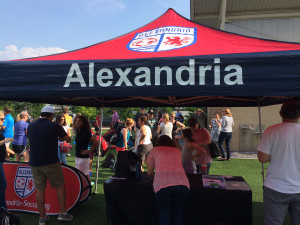ALEXANDRIA, Va. — It’s a steamy, spring afternoon a block off the main drag of Duke Street, just south of the Capital Beltway, where bright colored cones and nets are staggered across a large artificial turf field. There’s room for dozens of young soccer players to be split between a couple handfuls of games, as they try out in front of coaches to determine placement in the upcoming Alexandria Soccer Association (ASA) leagues. But there are large swaths of empty space between groups.
The reasons why the fields aren’t as full as hoped are layered, but they stem from the same root issue. Late last summer, U.S. Soccer announced that it would be switching its calendar from one based on the school year to one based on the calendar year, to better align itself with the international soccer calendar.
“Overall, the two things this accomplishes is it makes things easier and it gets us on the same calendar with the rest of the world,” said U.S. Youth Technical Director and U-20 Men’s National Team Coach Tab Ramos at the time.
“So now it becomes easier to identify for U.S. National Teams and everything else when it comes to international soccer.”
While that may be true, the players that make up the teams that compete on an international level are a fraction of a percent of the millions involved in youth soccer. And there are other, very real repercussions of the calendar change that are impacting players, parents and coaches across the country right now.
“The design previously was so that they could play with their classmates, play with their friends from school,” explained Tommy Park, ASA executive director as well as a DeMatha graduate and longtime coach at the school.
“The mandate has basically taken each miniature community that has formed on these teams — these best friend bonds, where parents are very tight, and coaches who have helped support them, whether it be recreational or competitive — and said that we’re going to chop four months into it and split them up.”
For competitive leagues, players born between the old Aug. 1 deadline and the new Jan. 1 deadline face the prospect of having to skip a level, jumping straight from a U7 recreational league to a U9 travel league, for instance, the first level where the mandate applies in Alexandria. That has scared some away from trying out, for fear of being unable to keep up physically. Where the ASA had 60 girls and 120 boys at tryouts last year, they have only 40 and 90 this year, respectively.
“For us, as we try to plan and really try to build a base of kids to play soccer year round, that’s a huge impact,” Park said. “I don’t think they thought that part of it through.”
ASA is fortunate to be one of the five largest clubs in the area, with over 4,000 participants. At some of the levels most affected by the new mandate, this has led to influx of enrollment in Alexandria, as kids from smaller clubs have moved over to those with more institutional support. But another fallout from the mandate affecting leagues large and small is that it splits up teams that have grown up playing together for years.

“I think the social side of the club sport is definitely something that needs to be addressed,” said Ryan Alexander, who coaches the U14 and U15 ASA girls teams, as well as the girls varsity team at Sidwell Friends.
“This is not a professional academy. This is not Manchester United, where we’re trying to mine two players to make the first team. There’s real life relationships and friendships.”
James Doyle is an ASA recreational age group coordinator, but also a parent of three soccer-playing kids. His eldest daughter is affected by the new mandate, jumping up from a U12 to a U14 league this year. He’s less worried about her transition on the field than off of it.
“I think that’s going to be a little bit of a social impact, playing with some girls she doesn’t know,” he said, but noted that Alexandria is lucky to have a fairly tight-knit soccer community.
“I think the parents are more concerned about this than the kids are.”
Parents have reason to be concerned from a competition standpoint as well. For kids pushed up by the deadline who haven’t physically matured as fast as their peers, there may be some serious intimidation about their ability to even play competitively this year.
“They may or may not be at a comfort level to even make a team,” Park said. “I think a lot of smaller clubs aren’t in position to support them, so they’re going to be cut out right away.”
On the other end of the spectrum, the most talented players face uncertainty as well. Teams that have grown together and succeeded in the past, rising into the top 50 nationally, are suddenly facing an unknown future, with a large percentage of their team being reassigned to another age group.
“The opportunities that they’ve been working to create, such as playing in a regional league or tournament, or a national final, are now threatened,” Park said.
That, in turn, has caused a groundswell of players considering leaving their organization entirely, looking for other clubs that might fit better. Alexander sees that as the biggest seismic shift caused by the deadline change.
“It has forced a lot of people to look at other clubs,” he said. “I think this year pushed a lot of people to explore that more than in years past.”
Because it’s not just about winning. Good teams attract more attention from college coaches, who recruit far more heavily from the club side than from high schools. When college scholarships are potentially at stake, players may be more inclined to start over in a new league.
U.S. Soccer did not respond to a request for comment about the affect the new mandate is having on youth soccer by the time of publication. But one look at the comments left on the announcement by angry parents and coaches from Ohio to Tennessee to California shows that teams across the country are feeling the same pressures.
Park says he and his team have done the best to preach the positives to his group — the opportunity to make new friends, build different relationships, come together as a community — but that it’s a tough sell when such a change is intended to benefit such a small group of players at the expense of the masses.
“We have 99 percent of the other kids playing soccer, and they’re not impacted by the international experience,” he said.
“If there was a reason that we could support, it would be easier. But in this case, nobody’s really sure why we would change our younger kids to a system that makes no sense.”






